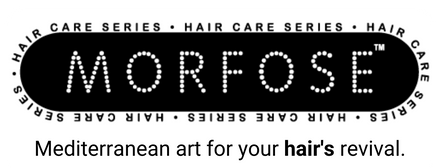Protecting Your Hair from Environmental Damage
Posted by MORFOSE COSMETICS

Guarding Your Locks: Protecting Your Hair from Environmental Harm
Your hair, a crowning glory, encounters a world of challenges daily, and many of these come from the environment. Whether it's the sun's harsh rays, pollutants in the air, or seasonal changes, your hair can take a beating. However, with the right strategies and protective measures, you can keep your locks looking healthy and vibrant. In this guide, we'll delve into the world of environmental hair care defense and reveal effective ways to shield your hair from damage.
Nature's Challenges: How Environmental Factors Impact Your Hair Health
Understanding how environmental factors can impact your hair health is the first step toward effective protection. Let's explore some of these challenges and their effects on your hair:
- UV Radiation: Prolonged exposure to the sun can lead to hair dryness, color fading, and even breakage. UV radiation damages the hair's protein structure and causes a lackluster appearance.
- Pollution: Airborne pollutants like dust and smoke can settle on your hair, making it dull and lifeless. These particles can also clog your scalp pores and hinder hair growth.
- Seasonal Changes: Weather shifts, especially in extreme conditions, can lead to hair problems. In cold, dry winters, hair may become brittle, while hot and humid summers can make hair frizzy and unmanageable.
- Humidity: High humidity can lead to frizz and unruly hair, while low humidity can cause dryness and static. Finding the right balance is essential for maintaining healthy hair.
Environmental Hair Defense 101: Shielding Your Locks from Damage
Now that we've identified the challenges, it's time to dive into effective strategies for protecting your hair from environmental harm. Environmental hair defense is all about taking proactive measures to maintain your hair's well-being:
- UV Protection: Invest in hair care products with UV protection, such as leave-in sprays or serums. These create a shield against the sun's harmful rays and help preserve your hair's color and shine.
- Cover Up: When spending extended time in the sun, consider wearing a wide-brimmed hat or a scarf to provide your hair with physical protection from UV radiation.
- Pollution Defense: Use a sulfate-free shampoo to cleanse your hair regularly and remove pollutants. To further shield your hair, rinse it with cool water after washing to close the hair cuticle and lock in moisture.
- Seasonal Hair Care: Adjust your hair care routine based on the season. In the winter, use hydrating products and avoid excessive heat styling. In the summer, focus on frizz control and use lightweight, hydrating products.
- Humidity Control: Use anti-frizz products and hair sprays that can help control frizz in high humidity. In low humidity, hydrate your hair with deep conditioning treatments and leave-in conditioners.
Resilience in the Elements: Strategies for Protecting Your Hair
Building resilience in the face of environmental challenges means adopting a holistic approach to your hair care. Consider these additional strategies to protect your locks:
- Nourishment from Within: A balanced diet rich in essential vitamins and minerals can strengthen your hair and make it more resilient. Incorporate foods like salmon, avocados, and nuts for optimal hair health.
- Quality Hair Products: Invest in high-quality hair care products made with natural ingredients. Read labels carefully and avoid products with harsh chemicals that can strip your hair of natural oils.
- Regular Haircuts: Regular trims can remove damaged ends and prevent further breakage. Trim your hair every 8-12 weeks, depending on your hair's needs.
- Scalp Care: Keep your scalp clean and healthy by exfoliating it to remove product buildup and maintaining proper moisture balance.
- Minimize Heat Styling: Limit the use of heat styling tools to prevent damage. When you do use them, apply a heat protectant to create a barrier between your hair and the heat.
Incorporating these strategies into your hair care routine will help you build resilience in the face of environmental challenges. By consistently following these practices and adapting your routine to the season and your hair's needs, you can successfully shield your hair from environmental harm and enjoy locks that stay healthy, vibrant, and full of life.

Guarding Your Locks: Protecting Your Hair from Environmental Harm
Your hair is your crowning glory, but it faces a daily barrage of challenges from the environment. Whether it's the scorching sun, air pollution, or the changing seasons, your hair can take a beating. However, fear not, for with the right strategies and protective measures, you can ensure your locks remain healthy, vibrant, and beautiful. In this comprehensive guide, we'll embark on a journey into the world of environmental hair care defense. We'll explore effective ways to shield your hair from environmental damage, allowing it to shine regardless of the elements it faces.
Nature's Challenges: How Environmental Factors Impact Your Hair Health
Before we delve into the protective strategies, it's crucial to understand how environmental factors can impact the health and appearance of your hair. Let's take a closer look at these challenges and their effects on your precious locks:
- UV Radiation: Prolonged exposure to the sun can lead to a range of hair problems. The sun's UV radiation can cause your hair to become dry, brittle, and prone to breakage. It can also lead to color fading, giving your locks a lackluster appearance.
- Pollution: Airborne pollutants such as dust, smoke, and particulate matter settle on your hair, making it appear dull and lifeless. These pollutants can also clog your scalp's pores, impeding healthy hair growth.
- Seasonal Changes: Your hair's resilience is tested as the seasons change. In the cold, dry winter months, your hair may become brittle and prone to static. Conversely, hot and humid summers can cause hair to become frizzy and challenging to manage.
- Humidity: High humidity can result in frizzy, unruly hair, while low humidity can cause dryness and static. Achieving the right balance is essential for maintaining healthy, beautiful hair.
Environmental Hair Defense 101: Shielding Your Locks from Damage
Now that we've identified the challenges, let's explore effective strategies and measures to protect your hair from environmental harm. Environmental hair defense is all about proactive steps you can take to ensure your hair's well-being:
- UV Protection: Invest in hair care products with built-in UV protection, such as leave-in sprays or serums. These products create a protective shield against the sun's harmful rays, helping to preserve your hair's color, shine, and overall health.
- Cover Up: When spending extended time in the sun, consider wearing a wide-brimmed hat, a scarf, or a stylish head wrap. These physical barriers provide your hair with extra protection from the damaging effects of UV radiation.
- Pollution Defense: Use a sulfate-free shampoo to cleanse your hair regularly, effectively removing accumulated pollutants. To further shield your hair, finish your hair wash with a refreshing rinse using cool water. This step helps close the hair cuticle, sealing in moisture and creating a protective barrier.
- Seasonal Hair Care: Customize your hair care routine to adapt to the changing seasons. During the dry winter months, focus on hydrating products and minimize the use of heat styling tools. In the summer, concentrate on frizz control and opt for lightweight, hydrating hair products.
- Humidity Control: Environmental humidity plays a significant role in your hair's behavior. Use anti-frizz products and hair sprays that are specifically designed to control frizz in high humidity conditions. In low humidity, revitalize your hair with deep conditioning treatments and leave-in conditioners to maintain optimal moisture balance.
Resilience in the Elements: Strategies for Protecting Your Hair
Building resilience in the face of environmental challenges means adopting a comprehensive approach to your hair care. Here are some additional strategies to help you protect your locks:
- Nourishment from Within: Your hair's strength and vitality begin with nourishment from within. A well-balanced diet rich in essential vitamins and minerals, such as those found in salmon, avocados, and nuts, can significantly contribute to the health and resilience of your hair.
- Quality Hair Products: Invest in high-quality hair care products that are made with natural ingredients. Carefully read product labels, and avoid those containing harsh chemicals that can strip your hair of its natural oils, leaving it vulnerable to environmental damage.
- Regular Haircuts: Regular trims are crucial for removing damaged ends and preventing further breakage. Aim to trim your hair every 8-12 weeks, depending on your hair's specific needs.
- Scalp Care: Keep your scalp clean and healthy by incorporating regular exfoliation into your hair care routine. Exfoliation helps remove product buildup and promotes proper moisture balance, ensuring your scalp is an ideal environment for healthy hair growth.
- Minimize Heat Styling: Limit the use of heat styling tools to prevent damage. When you do use such tools, apply a heat protectant product to create a protective barrier between your hair and the heat source.
Incorporating these strategies into your hair care routine will help you build resilience in the face of environmental challenges. By consistently following these practices and adapting your hair care routine to the changing seasons and your hair's specific needs, you can successfully shield your locks from environmental harm. This, in turn, will allow your hair to maintain its health, vibrancy, and youthful beauty, regardless of the environmental elements it encounters.
Don't let the elements compromise your hair's beauty. With the right knowledge and protective measures, you can continue to flaunt your stunning, healthy locks in any environment. Guarding your locks against environmental harm is a key part of maintaining your hair's allure and ensuring it looks its best year-round.


